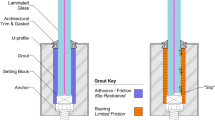Abstract
Approximate methods for calculating laminated glass (LG), a composite where thin polymeric layers are sandwiched by glass plies, are very useful in the design practice. The most common approach relies upon the definition of the effective thickness, i.e., the thickness of a glass monolith that, under the same boundary and load conditions, presents the same maximal stress or deflection of the laminate. Different alternative formulations have been proposed, but for flat glass only. Meeting the increasing interest for curved glazing in modern architecture, here the recent “Enhanced Effective Thickness” method is extended to the case of single-curvature LG panels. Under the assumption that the curvature is moderate, usually met in the practice, simple formulae for the effective thickness are proposed. A practical method is presented to calculate the relevant coefficients, which depend upon the geometry, load and boundary conditions. Comparison with numerical experiments in paradigmatic examples confirms the accuracy of the proposed approach.



























Similar content being viewed by others
Notes
In the case of curved architectural glass this hypothesis is verified, because R is of the order of several meters, while h is of the order of a few millimeters.
References
ABAQUS (2010) Analysis users manual, version 6.10. Simulia
Aşik M, Tezcan S (2005) A mathematical model for the behavior of laminated glass beams. Comput Struct 83:1742–1753
Ascione L, Fraternali F (1992) A penalty model for the analysis of curved composite beams. Comput Struct 45:985–999
Asik M, Dural E, Yetmez M, Uzhan T (2014) A mathematical model for the behavior of laminated curved glass beams. Compos Part B Eng 58:593–604
Behr RA, Minor JE, Norville HS (1993) Structural behavior of architectural laminated glass. J Struct Eng ASCE 119:202–222
Bennison SJ, Stelzer I (2009) Structural properties of laminated glass. Short course, glass performance days, Tampere (Finland)
Bhimaraddi A, Carr AJ, Moss PJ (1989) Generalized finite element analysis of laminated curved beams with constant curvature. Comput Struct 31:309–317
Nelson FC (1985) Curved members. In: Blake A (ed) Handbook of mechanics, materials, and structures. Wiley series in mechanical engineering practice. Wiley, London
Calderone I, Davies PS, Bennison SJ, Xiaokun H, Gang L (2009) Effective laminate thickness for the design of laminated glass. In: Proceedings of glass performance days, Tampere (Finland), pp 1–3
Eigensatz M, Kilian M, Schiftner A, Mitra NJ, Pottmann H, Pauly M (2010) Paneling architectural freeform surfaces. ACM Trans Graph 29:45:1–45:10
Foraboschi P (2007) Behavior and failure strength of laminated glass beams. J Eng Mech ASCE 133:1290–1301
Foraboschi P (2009) Analytical solution of two-layer beam taking into account non-linear interlayer slip. J Eng Mech ASCE 135:1129–1146
Frostig Y (1999) Bending of curved sandwich panels with a transversely flexible core—closed-form high-order theory. J Sandw Struct Mater 1:4–41
Galuppi L, Manara G, Royer-Carfagni G (2013) Practical expressions for the design of laminated glass. Compos Part B Eng 45:1677–1688
Galuppi L, Manara G, Royer-Carfagni G (2014) Erratum and addendum to practical expressions for the design of laminated glass (Compos Part B Eng 45:1677–1688, 2013). Compos Part B Eng 56:599–601
Galuppi L, Royer-Carfagni G (2012) Composite beams with viscoelastic interlayer. An application to laminated glass. Int J Sol Struct 49:2637–2645
Galuppi L, Royer-Carfagni G (2012) Effective thickness of laminated glass beams. New expression via a variational approach. Eng Struct 38:53–67
Galuppi L, Royer-Carfagni G (2012) The effective thickness of laminated glass plates. J Mech Mater Struct 7:375–400
Galuppi L, Royer-Carfagni G (2013) The design of laminated glass under time-dependent loading. Int J Mech Sci 68:67–75
Galuppi L, Royer-Carfagni G (2013) The effective thickness of laminated glass: inconsistency of the formulation in a proposal of EN-standards. Compos Part B Eng 55:109–118
Galuppi L, Royer-Carfagni G (2014) Enhanced effective thickness of multi-layered laminated glass. Compos Part B Eng 64:202–213
Galuppi L, Royer-Carfagni G (2014) Buckling phenomena in double curved cold-bent glass. Int J Non-Lin Mech 64:70–84
Galuppi L, Royer-Carfagni G (2015) Analytical approach à la Newmark for curved laminated glass. Compos Part B Eng 76:65–78
Galuppi L, Royer-Carfagni G (2015) Shear coupling effects of the core in curved sandwich beams. Compos Part B Eng 76:320–331
Hooper JA (1973) On the bending of architectural laminated glass. Int J Mech Sci 15:309–323
Ivanov IV (2006) Analysis, modelling, and optimization of laminated glasses as plane beam. Int J Sol Struct 43:6887–6907
Lenci S, Clementi F (2009) Simple mechanical model of curved beams by a 3D approach. J Eng Mech ASCE 135:597–613
National Research Council (Italy) CNR-DT-210: Istruzioni per la progettazione, l’esecuzione e il controllo di costruzioni con elementi strutturali in vetro (2013)
Newmark NM, Siess CP, Viest IM (1951) Tests and analysis of composite beams with incomplete interaction. Proc Soc Exp Stress Anal 9:75–92
Norville HS, King KW, Swofford JL (1998) Behavior and strength of laminated glass. J Eng Mech ASCE 124:46–53
American Society Testing of Materials (2009) E1300–09a. Standard Practice for Determining Load Resistance of Glass in Buildings, ASTM International
Microsoft Office
Pottmann H, Bo P, Schiftner A, Schmiedhofer H, Baldassini N and Wallner J (2008) Architectural freeform structures from single curved panels. ACM Trans Graph 27(3):45–48
Pottmann H, Schiftner A, Bo P, Baldassini N, Schmiedhofer H, Wang W, Wallner J (2008) Freeform surfaces from single curved panels. ACM Trans Graph 27(3):76:1–76:10
Sagan H (1992) Introduction to the calculus of variation. Dover, New York
Spillers WR (2002) Introduction to structures, Woodhead Publishing Series in Civil and Structural Engineering. Elsevier Science, Amsterdam
Wallerstein DV (2002) A variational approach to structural analysis, A Wiley-Interscience publication. Wiley, London
Wölfel E (1987) Nachgiebiger verbund - eine näherungslösung und deren anwendungsmöglichkeiten. Stahlbau 6:173–180
Acknowledgments
Support of the European Community European Community under Grant RFCS-RFSR-CT-2012-00026 “S+G” is gratefully acknowledged.
Author information
Authors and Affiliations
Corresponding author
Rights and permissions
About this article
Cite this article
Galuppi, L., Royer-Carfagni, G. Enhanced Effective Thickness (EET) of curved laminated glass. Ann. Solid Struct. Mech. 7, 71–92 (2015). https://doi.org/10.1007/s12356-015-0043-9
Received:
Accepted:
Published:
Issue Date:
DOI: https://doi.org/10.1007/s12356-015-0043-9




